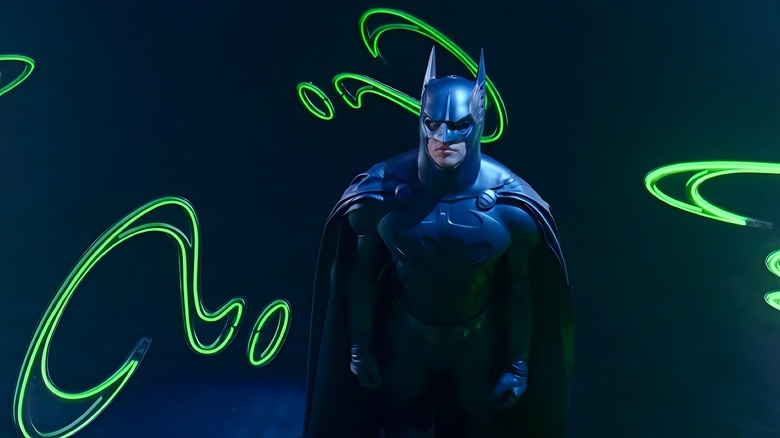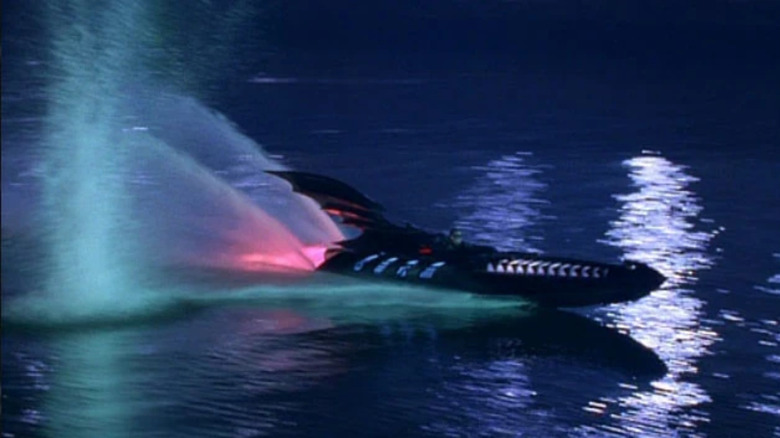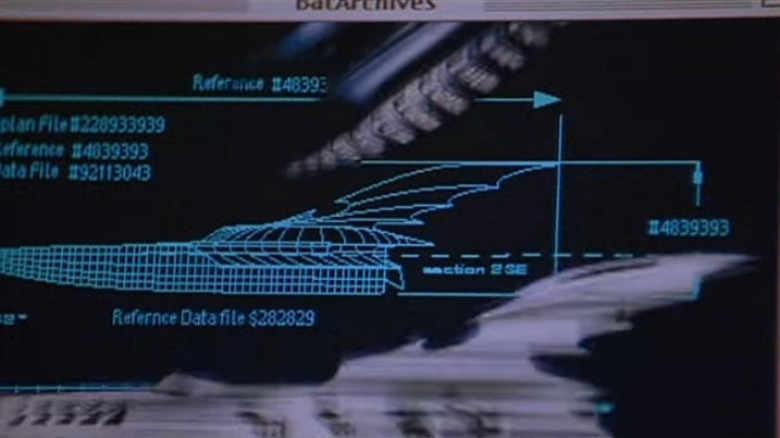Batman Forever Built A Real, Working Batboat For Just A Few Seconds Of Film
At the climax of Joel Schumacher's 1995 film "Batman Forever," the title hero (Val Kilmer) treks out to a foreboding island where the Riddler (Jim Carrey) is hiding out with an infernal machine and a kidnapping victim. He flies there in his Batwing airplane, while Robin (Chris O'Donnell) follows in a newly built Batboat, a ridged, H.R. Giger-like hydrofoil with an enormous bat tail. Batman and Robin stand next to the Boat for one scene as Robin gets in. In the following scene, Two-Face (Tommy Lee Jones) misfires missiles at the Batboat from the Riddler's home base, handily blowing it up. It was on screen for maybe two minutes. Why take a Batboat at all?
The cynicism within all of us will instantly point out that the Batboat was included in "Batman Forever" for purely commercial reasons; it was clearly an excuse for Warner Bros. to market one additional Batman toy tie-in product to the kids watching. The toyetic nature of "Batman Forever," and especially of its 1997 follow-up "Batman & Robin," has been well documented by the cast and the filmmakers. If Warner Bros. wanted a new Batman vehicle for the Toys "Я" Us shelves, then the filmmakers had to hustle to include it in the movie. Ditto for new costumes. The Batboat may have brought Batman to his destination in "Batman Forever," but more than anything, it was a tub toy.
Of course, Batman's toyetic bat-themed gadgets are a feature that has been with the character since his inception. Every version of Batman drives his own Batmobile, and every Batmobile inevitably becomes a toy. But the Batboat was no toy. As described in Mark Reinhart's 2005 book "The Batman Filmography: Live-Action Features, 1943 -1997," the "Forever" boat actually worked.
Die Fledermaus-Boot
Both the Batmobile and the Batboat, as seen in "Batman Forever," were designed by Tim Flattery, and were based on concept art by Barbara Ling. As stated above, the vehicles were clearly inspired by the works of Swiss surrealist H.R. Giger, whose art also famously inspired the creatures in "Alien" and "Species." The boat had ribcage-like ridges down the sides, and, it must be said, a noticeably phallic shape.
According to Reinhart's book, both vehicles were built to actually be operated. The Batmobile could indeed be driven around, and the Batboat was 100% seaworthy. The Batmobile's low-to-the-ground sports car design may not have been the most practical for traversing the rough, potholed streets and super-narrow alleyways of Gotham City, but it did look cool, especially in toy form. Also, at the very least, the Batmobile could drive up walls using a complicated cable/grappling hook system. The cable system was not part of the vehicle's practical makeup.
The boat was built by a company called V.I.P. Marine, a construction firm in Oregon that could build boats to order. V.I.P. went out of business in 2008 and was bought by Caddo Manufacturing of Shreveport, Louisiana. That, too, went out of business in 2013. It was a life-size toy that actual stunt drivers drove around in a pool. The actual boat that it was built on was not stated in Reinhart's book, but one might handily assume it was built from scratch. Sadly, when it came to blowing up the Batboat, the "Forever" filmmakers merely exploded the real thing. It was not preserved for a museum, or to rent to wealthy Batman fans for an afternoon's joyride.
The future of the Batboat
The Batboat did return for a cameo appearance in "Batman & Robin," albeit only virtually. When Barbara (Alicia Silverstone) breaks into Batman's Bat Computer, she finds a strange, swirling video of Batman vehicles drifting randomly across the screen. If one looks quickly, one can see the Batboat schematics float past the screen in the "BatArchives" folder. If the Batboat was rebuilt, one can only speculate. At the very least, a record of its existence was maintained.
Throughout the "Batman" feature films, most of the on-screen vehicles were indeed drivable or even flyable. The Bat-Copter in the 1966 film was indeed a real helicopter, and the boat a real boat. The 1966 Batmobile was built on a real, functioning concept car called the Lincoln Futura, introduced at a car show in 1955. The Batmobiles in Tim Buton's two "Batman" films could indeed be driven, and the Batmobile in "Batman Begins" was actually a massive tank-like structure that could go 100 mph.
Reinhart's book breaks our hearts, however, by pointing out that Batman's planes are not real. Throughout the films, Batman's flying vehicles have either been practical models or CGI constructions. In "Batman Forever," Barbara Ling and designer Matt Codd took the plane model from Burton's films, and added the Gigerian ribcage to it, making it look like the other vehicles in the film. There is, however, no life-size Bat Plane that an actor or a tourist could sit in.
That it looks real is merely the magic of movies.


